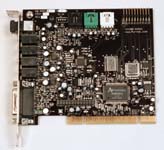Xitel Storm Platinum Gamer's Pack
by Mike Andrawes on June 13, 1999 9:37 PM EST- Posted in
- Smartphones
- Mobile
The Card
![]() Aureal's
Vortex 2 AU8830 chip pretty much determines all the features of the Storm Platinum.
Unlike the DSP based EMU10K1 on the Sound
Blaster Live!, the Vortex 2 is a fixed function chip. According to Aureal,
a fixed function chip can be up to 3 times more efficient than a general purpose
DSP. Of course, a DSP offers the ability to be upgraded with new features that
simply can't be done with a fixed function chip. If a fixed function chip gets
all the features right the first time, the flexibility of a DSP becomes a moot
point.
Aureal's
Vortex 2 AU8830 chip pretty much determines all the features of the Storm Platinum.
Unlike the DSP based EMU10K1 on the Sound
Blaster Live!, the Vortex 2 is a fixed function chip. According to Aureal,
a fixed function chip can be up to 3 times more efficient than a general purpose
DSP. Of course, a DSP offers the ability to be upgraded with new features that
simply can't be done with a fixed function chip. If a fixed function chip gets
all the features right the first time, the flexibility of a DSP becomes a moot
point.
Fortunately for Aureal, it really seems like they've got the feature set down with the Vortex 2, so that DSP probably won't be missed too much. It offers complete hardware acceleration 96 DMA channels, which equates to 92 DirectSound streams, 76 3D sound streams, or 64 wavetable voices after overhead is taken out. The claimed 320 voice wavetable is based on the option of up to 256 additional voices done in software. The Vortex 2 also handles most wavetracing operations in hardware using a 3D game's room geometry. The CPU just needs to perform the relatively simple vertex math of where the sound will travel while the hardware handles the effects applied to the sounds. Finally, there's a built in 10 channel hardware graphic equalizer.
Despite MIDI's ever decreasing usefulness, there a number of PC musicians out there that rely on MIDI. The Vortex 2's default wavetable set , which is stored in system RAM, is better than FM synthesis, but nowhere near as good as that offered by many professional level cards. Fortunately, there is a header for wavetable daughterboard on the Storm Platinum, and the addition of any number of wavetable daughter cards could easily remedy the MIDI situation. Further, since the samples are stored in system RAM, and the Vortex 2 supports DLS, it may be possible to just purchase and load an improved sample set in software.
The card itself is very closely based on Aureal's reference design - so close, in fact, that there is no mention of the Xitel or Storm Platinum names anywhere on the card itself, but rather just "Aureal Vortex 2" and the Aureal A3D logo silk screened on the back. The truth is that Aureal manufacturers almost all Vortex 2 based cards, with the only exception being the Turtle Beach models. This doesn't mean that they are all identical - Aureal manufactures them based on each company's specifications, which can vary widely.
Xitel has selected the Aureal's Vortex 2 SuperQuad Digital design for the Storm Platinum. As the name implies, the board features a digital out and outputs for four analog speakers. The digital out is an optical TOSLINK S/PDIF, the kind most often used by minidisc players. Most home receivers capable of decoding Dolby Digital AC-3 feature both coaxial and optical digital inputs. Xitel has specified an excellent 95dB signal to noise ratio with less than 0.007% THD, which allows the Storm Platinum to have virtually no back ground noise or hiss. The card itself does not extend beyond the end of the PCI connector, so should fit in any PCI slot just fine.
Speaking of Dolby Digital, with the proper DVD software, the digital output on the Storm Platinum can be used to output to a Dolby Digital receiver for full 5.1 surround. No such software is included with the Storm Platinum, but the current version of Zoran's SoftDVD, among others, is capable of doing this. Zoran's SoftDVD is also capable of taking the Dolby Digital data on a DVD disc and outputting it via A3D on a Vortex 2 card, which means 3D sound through headphones, 2 speakers, or 4 speakers. While not quite as good as true 5.1 Dolby Digital, the quad speaker output is significantly better than just plain stereo.











5 Comments
View All Comments
iosman - Wednesday, May 9, 2018 - link
Im in love with your content and also gain some knowledge from your blog.https://appvalleyandroid.com
https://192-168-l-254-ip.com
https://psiphonapp.com
iosman - Wednesday, May 9, 2018 - link
Love your blog man. Thanks for this stuff.https://tweakbox-app.com
https://tweakbox-app.org
https://gameguardianapp.com
AbbeyGrant - Saturday, June 9, 2018 - link
Now that's what I'm looking for clearly awesome thanks for the information.http://www.assist-login.com/fix-comcast-email-logi...
sandeeptinku - Thursday, August 2, 2018 - link
KingRoot is a Android program, which is largely built with the aim of rooting your smartphone.https://kingoroot-app.com/download/
https://kingoroot-app.com/
morgan4 - Thursday, June 20, 2019 - link
In love with this post.thankyou for the information.<a href="http://taylor411.com/salesforce-interview-question... lightning interview questions</a>